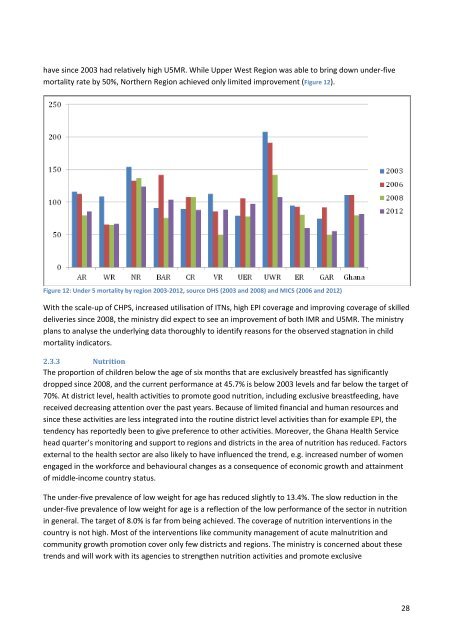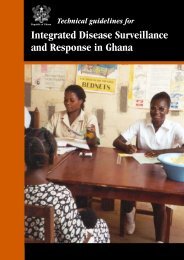2012 Holistic Assessment of Health Sector POW - Ministry of Health
2012 Holistic Assessment of Health Sector POW - Ministry of Health
2012 Holistic Assessment of Health Sector POW - Ministry of Health
You also want an ePaper? Increase the reach of your titles
YUMPU automatically turns print PDFs into web optimized ePapers that Google loves.
have since 2003 had relatively high U5MR. While Upper West Region was able to bring down under-five<br />
mortality rate by 50%, Northern Region achieved only limited improvement (Figure 12).<br />
Figure 12: Under 5 mortality by region 2003-<strong>2012</strong>, source DHS (2003 and 2008) and MICS (2006 and <strong>2012</strong>)<br />
With the scale-up <strong>of</strong> CHPS, increased utilisation <strong>of</strong> ITNs, high EPI coverage and improving coverage <strong>of</strong> skilled<br />
deliveries since 2008, the ministry did expect to see an improvement <strong>of</strong> both IMR and U5MR. The ministry<br />
plans to analyse the underlying data thoroughly to identify reasons for the observed stagnation in child<br />
mortality indicators.<br />
2.3.3 Nutrition<br />
The proportion <strong>of</strong> children below the age <strong>of</strong> six months that are exclusively breastfed has significantly<br />
dropped since 2008, and the current performance at 45.7% is below 2003 levels and far below the target <strong>of</strong><br />
70%. At district level, health activities to promote good nutrition, including exclusive breastfeeding, have<br />
received decreasing attention over the past years. Because <strong>of</strong> limited financial and human resources and<br />
since these activities are less integrated into the routine district level activities than for example EPI, the<br />
tendency has reportedly been to give preference to other activities. Moreover, the Ghana <strong>Health</strong> Service<br />
head quarter’s monitoring and support to regions and districts in the area <strong>of</strong> nutrition has reduced. Factors<br />
external to the health sector are also likely to have influenced the trend, e.g. increased number <strong>of</strong> women<br />
engaged in the workforce and behavioural changes as a consequence <strong>of</strong> economic growth and attainment<br />
<strong>of</strong> middle-income country status.<br />
The under-five prevalence <strong>of</strong> low weight for age has reduced slightly to 13.4%. The slow reduction in the<br />
under-five prevalence <strong>of</strong> low weight for age is a reflection <strong>of</strong> the low performance <strong>of</strong> the sector in nutrition<br />
in general. The target <strong>of</strong> 8.0% is far from being achieved. The coverage <strong>of</strong> nutrition interventions in the<br />
country is not high. Most <strong>of</strong> the interventions like community management <strong>of</strong> acute malnutrition and<br />
community growth promotion cover only few districts and regions. The ministry is concerned about these<br />
trends and will work with its agencies to strengthen nutrition activities and promote exclusive<br />
28















